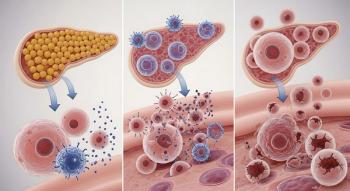
First-in-class therapy promising for Parkinson's disease psychosis
A first-in-class antipsychotic that is a selective serotonin inverse agonist (with no dopaminergic, histaminergic, adrenergic, or muscarinic activity) potentially targeting 5-HT2A receptors, improved Parkinson’s disease psychosis (PDP) with demonstrated safety and tolerability, and without worsening motor Parkinson’s, according to data presented in two posters at the 19th International Congress of Parkinson’s Disease and Movement Disorders (MDS), in San Diego.
A first-in-class antipsychotic that is a selective serotonin inverse agonist (with no dopaminergic, histaminergic, adrenergic, or muscarinic activity) potentially targeting 5-HT2A receptors, improved Parkinson’s disease psychosis (PDP) with demonstrated safety and tolerability, and without worsening motor Parkinson’s, according to data presented in 2 posters at the
Related:
According to the
Related:
Data from the integrated analysis of phase 3 studies continue to support the potential for pimavanserin (
An integrated analysis was performed on efficacy and tolerability data from two 6-week phase 3 placebo-controlled clinical trials with pimavanserin (40 mg) in PDP. In this large pooled sample of 268 patients from North America, pimavanserin showed highly significant improvement in psychosis compared to placebo on the 9-item SAPS-PD scale (P=.001) and demonstrated significant improvement on each of the separate hallucinations and delusions domains and also on secondary psychoses measures, including the Clinical Global Impression-Improvement (CGI-I) and the Clinical Global Impression-Severity (CGI-S) scales. Pimavanserin demonstrated significant improvement on nighttime sleep, daytime wakefulness and caregiver burden, representing additional potential clinically impactful benefits. Across studies, pimavanserin 40 mg also met the key secondary endpoint for motoric tolerability as measured using Parts II and III of the
As reported in a second poster, following participation in now complete blinded open-label studies, patients from the phase 2 or phase 3 studies had the option to remain on treatment on a once daily fixed dose of pimavanserin 40 mg. The open-label phase 2 study included 39 patients and the open label phase 3 study enrolled 459 patients at 114 international sites. While the study is ongoing, results presented at MDS from a preliminary analysis (capturing data through December 13, 2013) demonstrate a maintenance of benefit that was seen in the pivotal 6-week clinical trials. Investigators reported the median time to last dose is over 15 months and the discontinuation rate for lack of efficacy is ~20 percent or less. Persistent antipsychotic benefit (and benefit on caregiver burden) was observed across measures including SAPS-PD, other SAPS-based outcomes, CGI-I and CGI-S, leading investigators to conclude that pimavanserin may offer long-term benefit for patients with PDP with a demonstrated safety/tolerability profile appropriate for chronic use.
Dr Isaacson“Presently, treatment options for PDP are limited,” said Stuart Isaacson, MD, Parkinson’s Disease and Movement Disorders Center of Boca Raton, Fla. “While minimizing polypharmacy and identifying systemic triggers are first line, all antipsychotics worsen motor Parkinson's and cannot be used except for quetiapine and clozapine. However studies have failed to demonstrate consistent efficacy with quetiapine and it is also limited by sedation; clozapine has efficacy but requires extended blood test monitoring.”
In contrast, Dr Isaacson said that pimavanserin has efficacy, safety, and tolerability for the chronic treatment of patients with PDP.
Read next:
Newsletter
Get the latest industry news, event updates, and more from Managed healthcare Executive.

















































